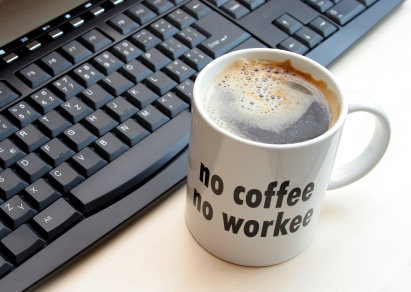Winston Churchill and Thomas Jefferson practiced this very simple act. They were ahead of their time. And now research is proving that their “quirky” habit may cut your risk of heart disease, diabetes, and even death.
How many times have you packed up to go home from work and realized you hadn’t left your desk all day? No coffee break. Not even a restroom break. A survey found 65 percent of workers stay at their desks for their lunch breaks. Or they don’t take one at all.1
You think you’re being productive. You’re getting more done by working nonstop at your desk all day. Right?
| While you’re up getting that cup of coffee and taking a break from sitting, ask a coworker how their day is going. A 10-minute conversation improves memory. So, you’re not only helping your body by moving but you’re actually exercising your brain. The more social interaction you have, the better your cognitive functioning will be. |
Wrong!
In reality you’re not doing either your job or your health any favors.
Staying at your desk and staring at your computer screen for hours isn’t just bad for your eyes…
In fact, sitting more than six hours in a day can increase your risk of dying by 54 percent.
Churchill and Jefferson stood frequently while working and writing. You’ll be surprised how beneficial their quirky habit really is…
After following over 17,000 people for 13 years, researchers at Pennington Biomedical Research Center found that people who sit most of the day increase their risk of dying from a heart attack by 54 percent.2 The American Cancer Society confirmed the results with an even bigger study. They followed more than 123,000 people for 14 years.3 Women who sat for more than six hours a day were 40 percent more likely to die. And men increased their risk by 20 percent.
Even scarier…people who exercised regularly but spent their day sitting had an increased risk too. In other words, you can’t undo the damage.
Sitting for prolonged hours shuts off the circulation of fat-absorbing enzymes.4
“The fat will recirculate in the blood stream and get stored as body fat or it can clog arteries and cause diseases,” said Dr. Marc Hamilton of the University of Missouri in Columbia. “The existing data, by numerous studies, are starting to show that the rates of heart disease and diabetes and obesity are doubled or sometimes even tripled in people who sit a lot.”
Your metabolism shuts down and your health degrades the longer you sit. That includes time spent sitting at work and at home. But when you stand and move around, your muscles use fat. And it naturally energizes you.
Think about it… When you get home from work how do you feel? Drained? Tired and ready to relax, right? Even though you were only sitting all day.
To keep your metabolism going, protect your heart and have more energy throughout the whole day, get up and move around. Not only does it protect your heart, it’s good for your work performance…
JourneyWell by HealthPartners conducted a seven-week study to see if a sit-to-stand desk unit helped employees’ productivity levels.5
The workers felt happier and more productive overall. Most of them felt more focused, healthier, and more energized.
Remind yourself to get up at least every couple of hours. Set an alarm if you have to.
The good news is that it doesn’t have to be much. Even just standing while you’re on a phone call, getting up for a cup of coffee or glass of water, or taking the stairs instead of the elevator are all small efforts to get your body moving. The important thing to remember is to move frequently throughout the day.
You’ll not just be healthier but you’ll be more productive…and happier.
And one more thing… Alternating between sitting and standing throughout the day is such a simple way to help your heart. You’ll barely notice the difference but your heart sure will. And there are so many other simple, safe, and natural ways to protect your heart. Even one cardiologist credits a real, natural solution to restoring the heart health in almost all of his patients. The best part is, it’s so easy to implement into your own life.
Like this Article? Forward this article here or Share on Facebook.
References:
1 http://usatoday30.usatoday.com/money/workplace/story/2012-04-15/lunch-at-work/54167808/1
2 http://ncbi.nlm.nih.gov/pubmed/19346988
3 http://aje.oxfordjournals.org/content/172/4/419.abstract
4 http://sciencedaily.com/videos/2008/0610-stand_up_for_your_health.htm
5 http://journeywell.com/jw/news-events/j8-1-2011.html

